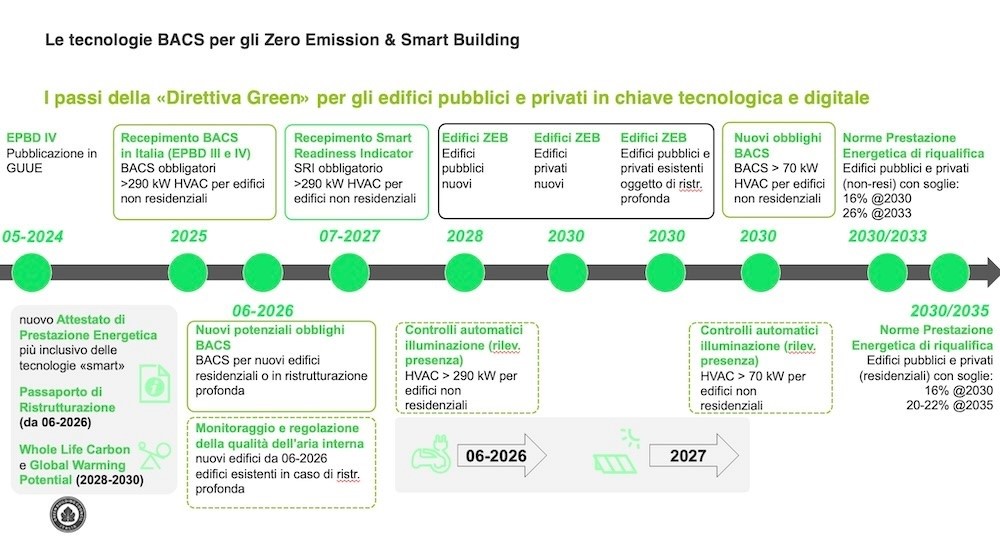The European regulatory landscape is becoming increasingly crucial in strengthening the connection between environmental sustainability goals and the digitalization of buildings.
The fourth revision of the Energy Performance of Buildings Directive (EPBD IV) marks a historic turning point, setting ambitious targets for both the medium and long term. The ultimate goal is the full decarbonization of the real estate sector by 2050—an actual revolution in the construction industry.
This entails a significant paradigm shift: transitioning from the concept of “nearly Zero-Energy Buildings” (nZEB) to that of “Zero-Emission Buildings.”
This change clearly reflects the European Union’s determination to further incentivize energy efficiency by promoting the adoption of innovative technological solutions.
The roadmap outlined by the “Green Homes” directive is both ambitious and tightly scheduled. Building Automation and Control Systems (BACS) are taking center stage, becoming mandatory for non-residential buildings with a thermal power output above 290 kW.
Moreover, starting from June 2026, new constructions and major renovations of residential buildings will also be required to integrate these technologies to ensure greater efficiency and sustainability.

SRI: The Strategic Tool for Smart Buildings
At the heart of the transformation toward smart buildings lies the Smart Readiness Indicator (SRI), a key component of the new legislation introduced by the EU. This indicator is designed to assess a building's level of "smartness" through the implementation of enabling technologies.
The SRI is based on three core pillars:
Optimization of energy efficiency: allows buildings to improve their overall performance.
Adaptability to occupants’ needs: technologies enable systems to be tailored according to users’ preferences and requirements.
Interaction with the electricity grid: promotes a flexible exchange between buildings and the power grid, facilitating the integration of renewable energy sources.
Although the SRI had been discussed for years, its regulatory role had long lacked a clear and binding framework. Today, however, its importance is officially recognized at the European level.
By June 2027, a delegated and implementing act will be published, reporting the results of testing activities conducted by the Member States.
To meet this deadline, pilot activities must be completed by June 2026, thus ensuring a consolidated and operational regulatory framework.

Why Seize This Opportunity?
The roadmap defined by the Smart Readiness Indicator (SRI) represents a crucial turning point for the future of buildings and energy efficiency worldwide. The transition to smart buildings is not just a response to sustainability objectives mandated by EU regulations, but also an opportunity to revolutionize the way buildings are designed, operated, and managed.
The introduction of the SRI enables a dual strategy: optimizing buildings’ energy performance and enhancing occupant comfort.
Smartdhome Srl
For over 12 years, we have been developing innovative solutions for energy consumption monitoring. Thanks to our accumulated experience and continuous technological development, we now support professionals in the HVAC, electrical, and energy sectors by offering complete, real-time monitoring and management solutions for homes and systems, aimed at achieving energy savings.
Contact Smartdhome Srl
Viale Longarone, 35 20058 – Zibido San Giacomo (MI) Tel. +39 024888631 –


